远程管理特洛伊木马(RAT)病毒
特洛伊木马工作原理分析及清除方法

在接受新的连接之前先关闭此连接 @如 果 不 是 ,
!
发现和清除木马
杀毒软件主要是针对已知病毒设计的, 而新病毒却层
出不穷, 特 别 是在 有 些 特 洛 伊 木 马 类 病 毒 刚 出 现 时 , 由于 杀毒软件没有建立病毒库, 大都无能为力。 因此, 学习一些 手工检查特洛伊木马的方法是很有必要的。 下面简单介绍 一种在 )"*]^ 系 统 下 手 工 发 现 和 清 除 木 马 的方法。 ( Q,07 ) 上, 客 123 服 务 程 序 都 需 要 %"#7&* 在 某 个 端 口 户 端 程 序 才 能 与 其 建 立 连 接, 进 行 数 据 传 输 。 可 以 用
J?,BHI?C 或 0 : J?,BHI?CJCKC"79 目 录 下 + , 然 后 在
注册表、 启动组和非启动组中设置好木马触发条件, 这样 木马的安装就完成了。以后, 当 木 马 被 触 发 条 件 激 活 时, 它就进入内存, 并开启事先定义的木马端口, 准备与控制 端建立连接。 进行控制 "#$ 建 立 连 接 , 建立一个木马连接必须满足 < 个条件: !6+ 服 务 端 已 服 务 端 都 要 在 线 。初 次 连 接 安 装 有木 马 程 序 。!<+ 控 制 端 、 时 还 需 要 知 道 服 务 端 的 ,G 地 址 。,G 地 址 一 般 通 过 木 马 程 序 的 信 息 反 馈 机 制 或扫描 固 定 端 口 等 方 式 得 到 。 木 马 连 接建立后, 控 制 端 端 口 和 木 马 端 口 之 间 将 会 有一 条 通 道 , 控 制 端 程 序 利用该通 道 与 服 务 端 上 的 木 马 程 序 取 得 联 系 , 并通过木马程序对服务端进行远程控制。
网络信息安全员(高级)——03恶意代码分析与防护

12
携带者对象
如果恶意软件是病毒,它会试图将携带者对象
作为攻击对象(也称为宿主)并感染它。目标携 带者对象的数量和类型随恶意软件的不同而大不 相同
可执行文件 脚本 宏 启动扇区
第3讲
13
传输机制
可移动媒体
网络共享
网络扫描
对等 (P2P) 网络
电子邮件
远程利用
第3讲
负载
后门 数据损坏或删除
信息窃取
拒绝服务 (DoS, DDoS) 系统关闭,带宽充满,网络DoS(如
SYN Flood) 服务中断(如DNS服务)
第3讲
触发机制
手动执行
社会工程
半自动执行
自动执行
定时炸弹 条件
第3讲
防护机制
装甲
这种类型的防护机制使用某种试图
防止对恶意代码进行分析的技术。这 种技术包括检测调试程序何时运行并 试图阻止恶意代码正常工作,或添加 许多无意义的代码,使人很难判断恶 意代码的用途。
第3讲
7
蠕虫
如果恶意代码进行复制,则它不是特洛伊木马,因此为了
更精确地定义恶意软件而要涉及到的下一个问题是:“代码 是否可在没有携带者的情况下进行复制?”即,它是否可以 在无须感染可执行文件的情况下进行复制?如果此问题的答 案为“是”,则此代码被认为是某种类型的蠕虫。 。
大多数蠕虫试图将其自身复制到宿主计算机上,然后使用
网络信息安全管理员
高级网络安全员培训
第三讲 恶意代码分析与防护
第三讲 恶意代码分析与防护
恶意软件概念 深层病毒防护 突发控制恢复
第3讲
第三讲 恶意代码分析与防护
恶意软件概念 深层病毒防护 突发控制恢复
木马的7种分类
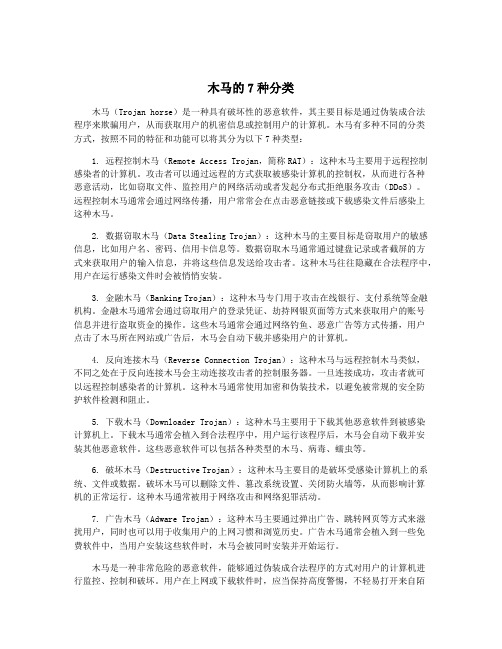
木马的7种分类木马(Trojan horse)是一种具有破坏性的恶意软件,其主要目标是通过伪装成合法程序来欺骗用户,从而获取用户的机密信息或控制用户的计算机。
木马有多种不同的分类方式,按照不同的特征和功能可以将其分为以下7种类型:1. 远程控制木马(Remote Access Trojan,简称RAT):这种木马主要用于远程控制感染者的计算机。
攻击者可以通过远程的方式获取被感染计算机的控制权,从而进行各种恶意活动,比如窃取文件、监控用户的网络活动或者发起分布式拒绝服务攻击(DDoS)。
远程控制木马通常会通过网络传播,用户常常会在点击恶意链接或下载感染文件后感染上这种木马。
2. 数据窃取木马(Data Stealing Trojan):这种木马的主要目标是窃取用户的敏感信息,比如用户名、密码、信用卡信息等。
数据窃取木马通常通过键盘记录或者截屏的方式来获取用户的输入信息,并将这些信息发送给攻击者。
这种木马往往隐藏在合法程序中,用户在运行感染文件时会被悄悄安装。
3. 金融木马(Banking Trojan):这种木马专门用于攻击在线银行、支付系统等金融机构。
金融木马通常会通过窃取用户的登录凭证、劫持网银页面等方式来获取用户的账号信息并进行盗取资金的操作。
这些木马通常会通过网络钓鱼、恶意广告等方式传播,用户点击了木马所在网站或广告后,木马会自动下载并感染用户的计算机。
4. 反向连接木马(Reverse Connection Trojan):这种木马与远程控制木马类似,不同之处在于反向连接木马会主动连接攻击者的控制服务器。
一旦连接成功,攻击者就可以远程控制感染者的计算机。
这种木马通常使用加密和伪装技术,以避免被常规的安全防护软件检测和阻止。
5. 下载木马(Downloader Trojan):这种木马主要用于下载其他恶意软件到被感染计算机上。
下载木马通常会植入到合法程序中,用户运行该程序后,木马会自动下载并安装其他恶意软件。
简述特洛伊木马的基本原理

简述特洛伊木马的基本原理
简述特洛伊木马的基本原理如下:
特洛伊木马是一种基于客户/服务器模式的网络程序,它通过隐藏在正常的程序中,并利用服务端的主机漏洞,以无孔不入的方式实现自己的目的。
一旦木马进入服务端,就会通过网络远程控制服务端的程序,例如打开后门、获取系统信息、执行任意操作等。
特洛伊木马通常包括控制端和服务端两个部分。
控制端用于远程控制服务端,可以执行任意操作,而服务端则被动的接收来自控制端的指令。
为了实现特洛伊木马的基本原理,需要满足以下三个条件:
1. 硬件部分:建立木马连接所必须的硬件实体,例如网络和设备。
2. 软件部分:实现远程控制所必须的软件程序,例如控制端程序和木马程序。
3. 具体连接部分:通过互联网在服务端和控制端之间建立一条木马通道所必须的元素,例如控制端IP、服务端IP、控制端端口和木马端口等。
特洛伊木马是一种非常危险的恶意软件,因为它可以完全控制服务端的程序,从而造成严重的安全威胁。
因此,我们应该时刻保持警惕,避免下载和安装不明来源的程序,并定期更新我们的操作系统和软件程序,以避免成为特洛伊木马的受害者。
防范特洛伊木马和病毒攻击的方法

VS
选择可靠的备份解决方案,如外部硬 盘驱动器、云存储或磁带备份,并确 保备份数据与原始数据保持同步。在 备份过程中,加密数据也是一个好习 惯,以保护数据的隐私和安全。
04
企业防范特洛伊木马和病 毒攻击的措施
建立完善的网络安全管理制度
制定严格的网络使用规定,限 制员工在工作时间和非工作场 合使用未知来源的软件和链接 。
建立24小时安全监控中心,实时监测网络流量和 安全事件,确保及时发现和处置安全威胁。
对已发生的安全事件进行深入分析,总结经验教 训,不断完善安全防范措施。
THANKS
感谢观看
建立网络访问控制和权限管理 机制,确保只有授权人员才能 访问敏感数据和系统资源。
定期审查和更新网络安全策略 ,以应对不断变化的网络威胁 。
对员工进行网络安全培训
提供定期的网络安全 培训课程,提高员工 对网络威胁的认识和 防范意识。
培养员工在发现可疑 网络活动时的报告和 处置能力。
指导员工如何识别和 避免网络钓鱼、恶意 软件等常见网络攻击 手段。
03 开启实时监控功能,对文件、邮件、网络等入口 进行安全防护。
谨慎打开未知来源的邮件和链接
不轻易打开来自陌生人的邮件和链接 ,特别是包含附件或跳转链接的邮件 。
使用可靠的邮件客户端,并开启垃圾 邮件过滤功能,减少潜在威胁的侵入 。
对于可疑邮件,不要轻易点击其中的 链接或下载附件,以免触发恶意程序 。
提高网络安全意识,不随意点击未知链接或下载未知文件
用户应提高网络安全意识,不随意点击来自不明来源的链接 或下载未知的文件。这些行为可能导致恶意软件的感染。
使用可靠的电子邮件服务和社交媒体平台,避免点击可疑的 附件或链接,特别是那些包含诱人的免费内容或奖品的链接 。
特洛伊木马分析

特洛伊木马分析特洛伊木马分析摘要在计算机如此普及的网络时代,病毒对于我们来说早已不是一个新鲜的名词,而通常被称为木马病毒的特洛伊木马也被广为所知,为了更好的保护自己的电脑我们应该了解跟多有关特洛伊病毒的信息。
本文对该病毒原理、预防和清除进行了详细的阐述,并对此发表了一些个人的看法。
关键词特洛伊木马病毒木马特洛伊木马是一种特殊的程序,它们不感染其他文件,不破坏系统,不自身复制和传播。
在它们身上找不到病毒的特点,但它们们仍然被列为计算机病毒的行列。
它们的名声不如计算机病毒广,但它们的作用却远比病毒大。
利用特洛伊木马,远程用户可以对你的计算机进行任意操作(当然物理的除外),可以利用它们传播病毒,盗取密码,删除文件,破坏系统。
于是这个在网络安全界扮演重要角色,课进行超强功能远程管理的“功臣”,自然而然也被列为受打击的行列。
在网络上,各种各样的特洛伊木马已经多如牛毛,它们和蠕虫病毒、垃圾邮件一起构成了影响网络正常秩序的三大害。
下面我就来说说特洛伊木马的特点、工作原理、预防和清除的方法,以及我自己对木马病毒及其防护方法的一些见解。
一.什么是特洛伊木马特洛伊木马简称木马,英文名为Trojan。
它是一种不同于病毒,但仍有破坏性的程序,普通木马最明显的一个特征就是本身可以被执行,所以一般情况下它们是由.exe文件组成的,某些特殊木马也许还有其他部分,或者只有一个.dll文件。
木马常被用来做远程控制、偷盗密码等活动。
惯用伎俩是想办法让远程主机执行木马程序,或者主动入侵到远程主机,上传木马后再远程执行。
当木马在远程主机被执行后,就等待可控制程序连接,一旦连接成功,就可以对远程主机实施各种木马功能限定内的操作。
功能强大的木马可以在远程主机中做任何事情,就如同在自己的机器上操作一样方便。
可见,木马实际上就是一个具有特定功能的可以里应外合的后门程序,将其与其他的病毒程序结合起来造成的危害将会是相当大的。
二.木马的工作原理当木马程序或藏有木马的程序被执行后,木马首先会在系统中潜伏下来,并会想办法使自己在每次开机时自动加载,以达到长期控制目标的目的。
特洛伊木马病毒是什么

特洛伊木马病毒是什么特洛伊木马是一种恶意程序,它们悄悄地在宿主机器上运行,就在用户毫无察觉的情况下,让攻击者获得了远程访问和控制系统的权限。
接下来由店铺为大家推荐什么是特洛伊木马病毒,希望对你有所帮助!特洛伊木马病毒的详细解释:一般而言,大多数特洛伊木马都模仿一些正规的远程控制软件的功能,如Symantec的pcAnywhere,但特洛伊木马也有一些明显的特点,例如它的安装和操作都是在隐蔽之中完成。
攻击者经常把特洛伊木马隐藏在一些游戏或小软件之中,诱使粗心的用户在自己的机器上运行。
最常见的情况是,上当的用户要么从不正规的网站下载和运行了带恶意代码的软件,要么不小心点击了带恶意代码的邮件附件。
大多数特洛伊木马包括客户端和服务器端两个部分。
攻击者利用一种称为绑定程序的工具将服务器部分绑定到某个合法软件上,诱使用户运行合法软件。
只要用户一运行软件,特洛伊木马的服务器部分就在用户毫无知觉的情况下完成了安装过程。
通常,特洛伊木马的服务器部分都是可以定制的,攻击者可以定制的项目一般包括:服务器运行的IP端口号,程序启动时机,如何发出调用,如何隐身,是否加密。
另外,攻击者还可以设置登录服务器的密码、确定通信方式。
服务器向攻击者通知的方式可能是发送一个email,宣告自己当前已成功接管的机器;或者可能是联系某个隐藏的Internet交流通道,广播被侵占机器的IP地址;另外,当特洛伊木马的服务器部分启动之后,它还可以直接与攻击者机器上运行的客户程序通过预先定义的端口进行通信。
不管特洛伊木马的服务器和客户程序如何建立联系,有一点是不变的,攻击者总是利用客户程序向服务器程序发送命令,达到操控用户机器的目的。
特洛伊木马攻击者既可以随心所欲地查看已被入侵的机器,也可以用广播方式发布命令,指示所有在他控制之下的特洛伊木马一起行动,或者向更广泛的范围传播,或者做其他危险的事情。
实际上,只要用一个预先定义好的关键词,就可以让所有被入侵的机器格式化自己的硬盘,或者向另一台主机发起攻击。
恶意程序的不同类型
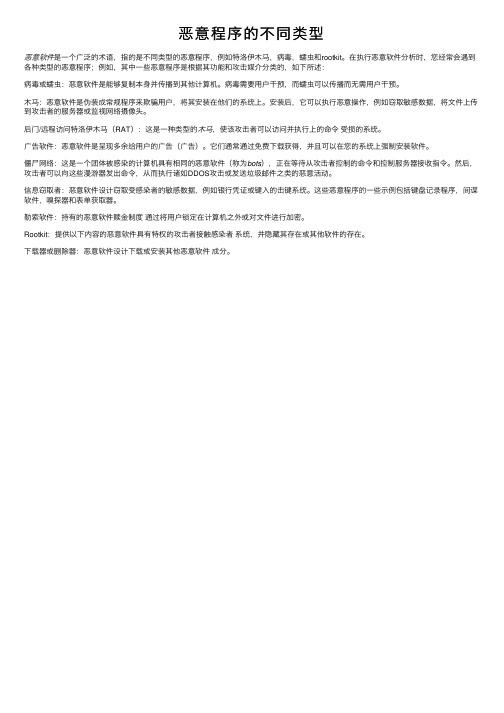
恶意程序的不同类型
恶意软件是⼀个⼴泛的术语,指的是不同类型的恶意程序,例如特洛伊⽊马,病毒,蠕⾍和rootkit。
在执⾏恶意软件分析时,您经常会遇到各种类型的恶意程序;例如,其中⼀些恶意程序是根据其功能和攻击媒介分类的,如下所述:
病毒或蠕⾍:恶意软件是能够复制本⾝并传播到其他计算机。
病毒需要⽤户⼲预,⽽蠕⾍可以传播⽽⽆需⽤户⼲预。
⽊马:恶意软件是伪装成常规程序来欺骗⽤户,将其安装在他们的系统上。
安装后,它可以执⾏恶意操作,例如窃取敏感数据,将⽂件上传到攻击者的服务器或监视⽹络摄像头。
后门/远程访问特洛伊⽊马(RAT):这是⼀种类型的⽊马,使该攻击者可以访问并执⾏上的命令受损的系统。
⼴告软件:恶意软件是呈现多余给⽤户的⼴告(⼴告)。
它们通常通过免费下载获得,并且可以在您的系统上强制安装软件。
僵⼫⽹络:这是⼀个团体被感染的计算机具有相同的恶意软件(称为bots),正在等待从攻击者控制的命令和控制服务器接收指令。
然后,攻击者可以向这些漫游器发出命令,从⽽执⾏诸如DDOS攻击或发送垃圾邮件之类的恶意活动。
信息窃取者:恶意软件设计窃取受感染者的敏感数据,例如银⾏凭证或键⼊的击键系统。
这些恶意程序的⼀些⽰例包括键盘记录程序,间谍软件,嗅探器和表单获取器。
勒索软件:持有的恶意软件赎⾦制度通过将⽤户锁定在计算机之外或对⽂件进⾏加密。
Rootkit:提供以下内容的恶意软件具有特权的攻击者接触感染者系统,并隐藏其存在或其他软件的存在。
下载器或删除器:恶意软件设计下载或安装其他恶意软件成分。
特洛伊病毒
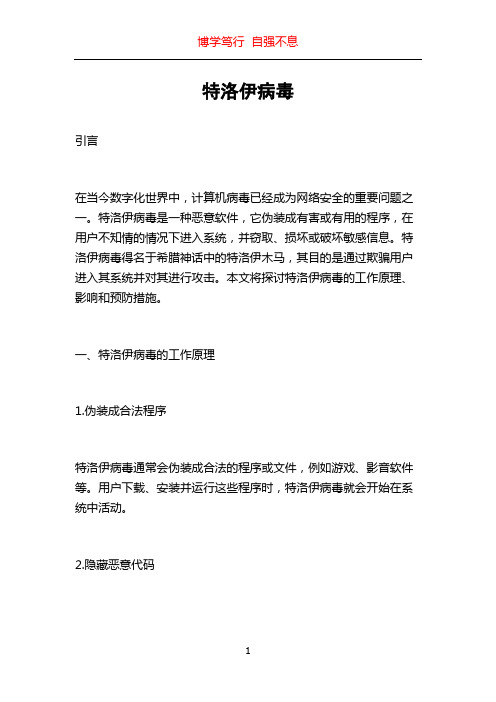
特洛伊病毒引言在当今数字化世界中,计算机病毒已经成为网络安全的重要问题之一。
特洛伊病毒是一种恶意软件,它伪装成有害或有用的程序,在用户不知情的情况下进入系统,并窃取、损坏或破坏敏感信息。
特洛伊病毒得名于希腊神话中的特洛伊木马,其目的是通过欺骗用户进入其系统并对其进行攻击。
本文将探讨特洛伊病毒的工作原理、影响和预防措施。
一、特洛伊病毒的工作原理1.伪装成合法程序特洛伊病毒通常会伪装成合法的程序或文件,例如游戏、影音软件等。
用户下载、安装并运行这些程序时,特洛伊病毒就会开始在系统中活动。
2.隐藏恶意代码特洛伊病毒通常会隐藏自己的恶意代码,使其难以被发现。
它可以在系统的注册表、启动项、系统文件等关键位置嵌入自己的代码,以便能够在系统启动时自动运行。
3.远程控制特洛伊病毒一旦进入系统,攻击者就可以远程控制受感染的计算机。
攻击者可以通过特洛伊软件远程访问文件、操控系统、监视用户活动等,而用户则完全不知情。
二、特洛伊病毒的影响1.数据窃取特洛伊病毒可以窃取用户的个人信息,如账户名、密码、信用卡信息等。
这些信息可能被用来进行金融欺诈、身份盗用等非法活动。
2.文件损坏或删除特洛伊病毒还可以损坏或删除用户的文件和数据。
它可以破坏硬盘驱动器、操作系统文件和应用程序,导致系统不稳定或无法正常工作。
3.操控系统特洛伊病毒给攻击者提供了远程操控计算机的能力。
攻击者可以在用户不知情的情况下操纵计算机执行不法行为,例如发起DDoS攻击、散布垃圾邮件等。
三、特洛伊病毒的预防措施1.安装可信的安全软件为了避免特洛伊病毒的感染,用户应该安装一个可信的安全软件,如杀毒软件和防火墙。
这些软件可以帮助检测和阻止病毒、恶意软件的入侵。
2.谨慎下载和安装软件用户在下载和安装软件时应格外谨慎。
应只从官方网站或可信的下载平台下载软件,并确保软件的完整性和正当性。
3.定期更新操作系统和软件及时更新操作系统和软件是防止特洛伊病毒侵入的重要步骤。
更新可以修复安全漏洞,并添加新的防御机制来阻止病毒的入侵。
木马与远程控制课件

02
木马的工作原理
木马的启动过程
木马程序的启动
木马程序通过各种方式在系统中启动,例如通过系统启动项、任 务计划程序、系统服务等。
木马程序的隐藏
一旦木马程序启动,它会隐藏在系统中,避免被用户发现。
木马程序的自启动
木马程序可以通过修改注册表、创建系统服务等方式实现自启动 ,确保在系统重启后仍然能够自动运行。
加强安全防范意识
01
了解木马与远程控制的基本 概念和危害,认识到安全防
范的重要性。
02
掌握常见的木马与远程控制 攻击手段和防范方法,提高
安全意识和技能。
03
培养良好的安全习惯,如不 随意下载未知来源的软件、 不轻信陌生人的链接和文件
等。
定期更新操作系统和应用程序
01
02
及时更新操作系统和应用程序,确保使用最新版本,以避免已知的漏 洞和安全隐患。
木马的历史与现状
木马的历史
木马的历史可以追溯到20世纪90年代初,当时一些黑客开始利用木马进行攻击。 随着互联网的发展和普及,木马的数量和种类也越来越多,成为计算机安全领域 的一个重要问题。
木马的现状
目前,木马仍然是计算机安全领域的一个主要威胁。黑客可以利用各种新技术和 新手段来制作和传播木马,如利用社交工程、加密技术、多态变形等。同时,反 病毒软件和安全技术的不断发展也使得木马的生存和传播更加困难。
木马的主要目的是通过远程控制用户计算 机,从而获取用户的敏感信息、破坏用户 的系统或执行其他恶意行为。
木马可以通过各种途径传播,如通过社交 工程、恶意网站、下载的软件或电子邮件 等。
木马的分类
后门木马
后门木马是一种常见的木马类型,它允许攻击者通过远程访问和控制受害者的计算机。攻 击者可以利用后门木马窃取敏感信息、修改系统设置、执行恶意代码等。
常用木马类型全总结
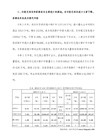
CODE
Spy-ware
CODE
间谍软件~请大家不要以为这个是密码截取软件哦~~黑白网络知道吧~
会员软件里有一半是间谍软件~也许大家也经常听说某位仁兄因为非法监控他老婆或者什么人的隐私而受到惩罚(还要说吗~当然是上法院!赔钱了!夫妻需要作这么绝吗??)一般间谍软件都是监控别人键盘记录(不光密码--还有聊天记录)可以定时截屏发送您的信箱还哟一堆BT功能·间谍软件一般很少会被杀~不过也有许多ANTI-spyware的软件~怎么说呢这类软件我也没有接触过多少~只是出来就适用一下~看来以后还要多研究一下~要天天监控老鼠!!!!!老鼠:我抗议!!我没哟隐私了~
CODE
黑洞,广外男/女生,灰鸽子,包括我们的元老级产品~冰河~,国外的Beast,Assasin
Sub7,等等~不下于~上千种~(一些杀毒软件生成可以杀15000种木马~不知道是否真的有这么多?)这些软件都是非法的远程控制软件~隐蔽性高~虽然没有NTrootkit高(有些已经有这样的功能了~比如NWC RAT等~木马)功能全~全得可怕~sub7 2.2竟然可以和对方玩游戏和~嗅探抓包功能~隐蔽性来说从一开始的EXE开发到现在流行的DLL进程插入型,黑洞还有 VXD型~。启动方式从原来的修改注册表的启动项到文件关联,文件捆绑~再到现在的NT服务加载和OCX关联~·连接方式从主动连接~到IP反弹~现在还有多种反弹方式~Email,DNS,FTP文件读取,~还有不用中转服务器直接连接~功能上~除了刚才说的游戏什么的功能常用的还有,文件管理,注册表管理,屏幕控制等功能外~还有远程视屏监控和音频监听(这个好像元老级的BO2K就有)还有的木马以恶作剧出名等等~~~也许你知道的比我多我就不说了~没有提到的软件请跟帖
CODE
计算机病毒蠕虫和特洛伊木马介绍

计算机病毒蠕虫和特洛伊木马介绍1. 计算机病毒:计算机病毒是一种能够通过感染文件或程序,在计算机系统中自我复制的恶意软件。
一旦感染,病毒可以破坏数据、使系统变得不稳定,甚至使系统无法正常运行。
计算机病毒可以通过下载不安全的文件、打开感染的电子邮件附件或访问感染的网页而传播。
2. 计算机蠕虫:计算机蠕虫是一种独立的恶意软件,可以在网络上自我传播,它会利用计算机系统中的漏洞来感染其他系统。
与病毒不同的是,蠕虫不需要依赖于宿主文件,它可以通过网络传播,对计算机系统和网络造成广泛的破坏。
3. 特洛伊木马:特洛伊木马是一种伪装成有用软件的恶意软件,一旦被用户下载并安装,它会在系统中植入后门,使攻击者可以远程控制计算机系统。
特洛伊木马通常会窃取用户的个人信息、登录凭据,或者开启摄像头和麦克风进行监视。
为了保护计算机系统免受这些恶意软件的侵害,用户可以使用防病毒软件、防火墙和定期更新操作系统来加强安全措施。
此外,用户还应该避免点击不明来源的链接、下载未知来源的文件,以及定期备份重要数据,以防止数据丢失。
计算机病毒、蠕虫和特洛伊木马是网络安全领域中的三大主要威胁。
它们对个人用户、企业和政府机构造成了严重的风险。
因此,了解这些恶意软件如何传播和运作,以及如何保护计算机系统不受其侵害,对于网络安全非常重要。
计算机病毒、蠕虫和特洛伊木马之间的区别在于它们的传播方式和目标。
计算机病毒依赖于宿主文件,它会将自身复制到其他文件中,并通过共享文件或网络传播。
蠕虫不需要宿主文件,它可以自行传播到其他计算机系统,甚至可以利用网络中的漏洞。
而特洛伊木马通常是伪装成有用软件或文件,一旦被用户下载并安装,就会植入后门,以便攻击者远程控制系统。
这些恶意软件对计算机系统造成的危害包括数据泄露、系统瘫痪、信息窃取,甚至网络攻击。
因此,保护计算机系统免受这些威胁的侵害至关重要。
为了防范计算机病毒、蠕虫和特洛伊木马,用户可以采取一些预防措施,包括使用受信任的防病毒软件和防火墙、定期更新操作系统和应用程序、避免下载和安装来历不明的软件或文件、谨慎点击不明来源的链接和附件,以及定期备份重要数据。
Windows 木马远程控制技术
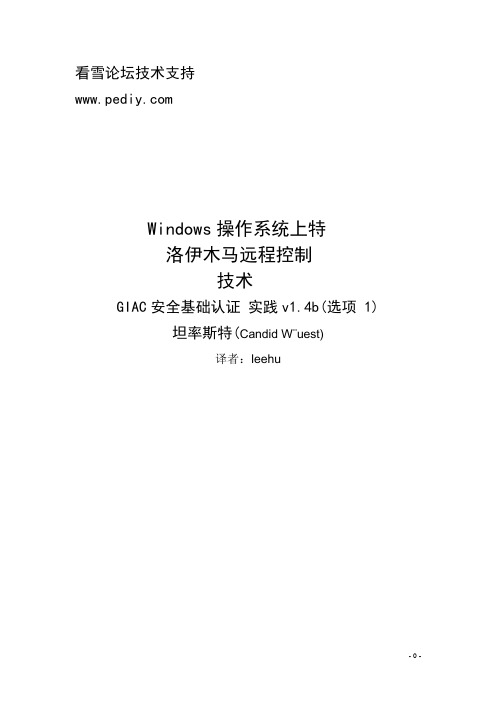
看雪论坛技术支持Windows操作系统上特洛伊木马远程控制技术GIAC安全基础认证实践v1.4b(选项 1)坦率斯特(Candid W¨uest)译者:leehu在Windows操作系统上特洛伊木马病毒已经出现了很长的时间,像SubSeven或者NETBUS,script kiddies从来都没有认真对待过它们而且只是当做玩具一样。
本文将介绍这些恶意软件的演变以及解释为什么它们会在不久的将来成为系统管理员的一个真正的威胁。
并概括通信技术最新的发展方向,并将其优势和不足之处与传统技术进行对比。
在这个基础之上,介绍并讨论一些可能被攻击的情况以及防御方法。
指出一般的防御措施和还需要改进的地方。
第一章绪论................................................................................................................................ - 3 -1.1定义................................................................................................................................ - 3 -1.1.1后门..................................................................................................................... - 3 -1.1.2Rootkit .................................................................................................................. - 3 -1.1.3远程控制木马..................................................................................................... - 3 -1.1.4键盘记录............................................................................................................. - 4 -1.1.5Dropper ................................................................................................................ - 4 -1.2动机................................................................................................................................ - 4 -1.3大纲................................................................................................................................ - 4 - 第二章标准通信技术................................................................................................................ - 5 -2.1基本通信........................................................................................................................ - 5 -2.2端口隐藏模式................................................................................................................ - 5 - 第三章防御工具........................................................................................................................ - 7 -3.1反病毒工具.................................................................................................................... - 7 -3.2个人防火墙.................................................................................................................... - 7 -3.3反木马工具.................................................................................................................... - 8 - 第四章最新技术........................................................................................................................ - 9 -4.1 DLL注入....................................................................................................................... - 9 -4.2 进程注入....................................................................................................................... - 9 -4.3 结束进程....................................................................................................................... - 9 -4.4 修改进程..................................................................................................................... - 10 -4.5 更改配置..................................................................................................................... - 10 -4.6 绕过堆栈保护............................................................................................................. - 11 -4.7 网络隧道..................................................................................................................... - 11 -4.7.1简单网络隧道................................................................................................... - 11 -4.7.2 高级网络隧道.................................................................................................. - 11 -4.8 多态代码..................................................................................................................... - 12 - 第五章今后的情况.................................................................................................................. - 13 - 第六章结论.............................................................................................................................. - 14 - 参考文献.................................................................................................................................... - 15 -第一章绪论1.1定义以下Rita Summers给出并被人们广泛接受的的定义:特洛伊木马是指潜伏在用户电脑中,窃取本机信息或者控制权以产生安全威胁的程序。
计算机病毒和木马区别是什么

计算机病毒和木马区别是什么计算机病毒和木马区别一:trojan horse(特洛伊木马)trojan horse经常也被仅仅称为trojan,是一种声称做一件事情而实际上做另外一件事情的程序。
不是总是破坏性的或者恶意的,它们常常与侦测文件、重写硬盘驱动器之类的事情有关或者被用于为攻击者提供一个系统的远程访问权限。
经典的木马包括作为游戏文件传送的键盘记录器或者伪装成有用应用程序的文件删除者。
木马可以用于多种目的,包括:远程访问(有时称为远程访问工具或rat’s或者后门)键盘记录于盗取密码(大部分间谍软件属于此类)virus(病毒)病毒是一种通过拷贝自身或者准确地说以一种改进的形式进入其他一段可执行代码中的程序。
病毒可以使用很多类型的宿主,最常见的一些是:可执行文件(例如您的计算机上的程序)引导扇区(告诉您的计算机从那里找到用于“引导”或者开启的代码部分)脚本文件(例如windows脚本或者visual basic脚本)宏文件(这种现在非常少见了,因为宏在例如微软word程序中不会默认执行)当一个病毒把自身嵌入了其他可执行代码中时,这就保证了当其他代码运行时它也运行,并且病毒会通过在每次运行的时候搜索其他“干净”宿主的方式传播。
有些病毒会重写原始文件,有效地破坏它们但是很多仅仅是简单地插入成为宿主程序的一部分,因此两者都能幸存。
取决于它们的编码方式,病毒可以通过许多系统文件、网络共享文件、文档里和磁盘引导区里传播。
尽管某些病毒通过电子邮件传播,但是这样并不能使它们成为病毒,并且事实上,大多数在电子邮件中传播的东西实际上是蠕虫。
要成为一个病毒,这个代码只需要去复制,它不需要造成很多损害,或者甚至不需要广泛地传播(参看payload)。
计算机病毒和木马区别二:病毒是恶意代码,能破坏和删除文件或自我复制,木马是控制程序,黑客通过木马植入控制电脑进行操作,如盗号等,木马不是病毒,不会直接对电脑产生危害,以控制为主。
计算机病毒和木马区别是什么
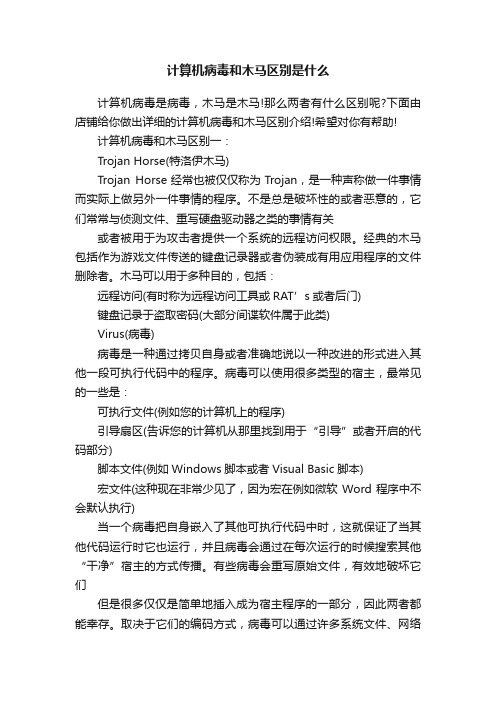
计算机病毒和木马区别是什么计算机病毒是病毒,木马是木马!那么两者有什么区别呢?下面由店铺给你做出详细的计算机病毒和木马区别介绍!希望对你有帮助!计算机病毒和木马区别一:Trojan Horse(特洛伊木马)Trojan Horse经常也被仅仅称为Trojan,是一种声称做一件事情而实际上做另外一件事情的程序。
不是总是破坏性的或者恶意的,它们常常与侦测文件、重写硬盘驱动器之类的事情有关或者被用于为攻击者提供一个系统的远程访问权限。
经典的木马包括作为游戏文件传送的键盘记录器或者伪装成有用应用程序的文件删除者。
木马可以用于多种目的,包括:远程访问(有时称为远程访问工具或RAT’s或者后门)键盘记录于盗取密码(大部分间谍软件属于此类)Virus(病毒)病毒是一种通过拷贝自身或者准确地说以一种改进的形式进入其他一段可执行代码中的程序。
病毒可以使用很多类型的宿主,最常见的一些是:可执行文件(例如您的计算机上的程序)引导扇区(告诉您的计算机从那里找到用于“引导”或者开启的代码部分)脚本文件(例如Windows脚本或者Visual Basic脚本)宏文件(这种现在非常少见了,因为宏在例如微软Word程序中不会默认执行)当一个病毒把自身嵌入了其他可执行代码中时,这就保证了当其他代码运行时它也运行,并且病毒会通过在每次运行的时候搜索其他“干净”宿主的方式传播。
有些病毒会重写原始文件,有效地破坏它们但是很多仅仅是简单地插入成为宿主程序的一部分,因此两者都能幸存。
取决于它们的编码方式,病毒可以通过许多系统文件、网络共享文件、文档里和磁盘引导区里传播。
尽管某些病毒通过电子邮件传播,但是这样并不能使它们成为病毒,并且事实上,大多数在电子邮件中传播的东西实际上是蠕虫。
要成为一个病毒,这个代码只需要去复制,它不需要造成很多损害,或者甚至不需要广泛地传播(参看Payload)。
计算机病毒和木马区别二:病毒是恶意代码,能破坏和删除文件或自我复制,木马是控制程序,黑客通过木马植入控制电脑进行操作,如盗号等,木马不是病毒,不会直接对电脑产生危害,以控制为主。
rat网络安全
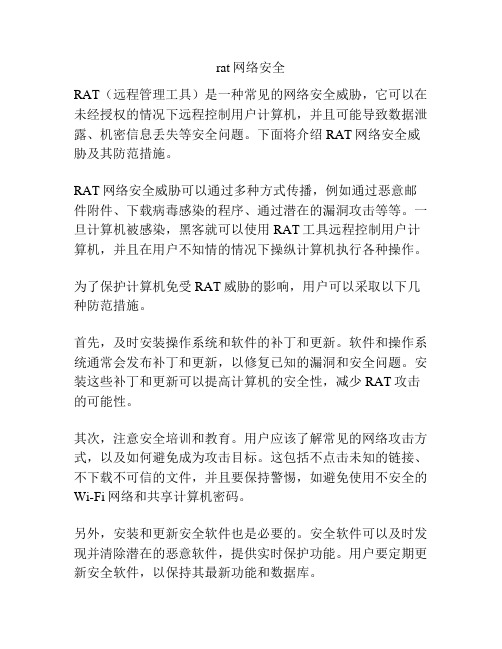
rat网络安全RAT(远程管理工具)是一种常见的网络安全威胁,它可以在未经授权的情况下远程控制用户计算机,并且可能导致数据泄露、机密信息丢失等安全问题。
下面将介绍RAT网络安全威胁及其防范措施。
RAT网络安全威胁可以通过多种方式传播,例如通过恶意邮件附件、下载病毒感染的程序、通过潜在的漏洞攻击等等。
一旦计算机被感染,黑客就可以使用RAT工具远程控制用户计算机,并且在用户不知情的情况下操纵计算机执行各种操作。
为了保护计算机免受RAT威胁的影响,用户可以采取以下几种防范措施。
首先,及时安装操作系统和软件的补丁和更新。
软件和操作系统通常会发布补丁和更新,以修复已知的漏洞和安全问题。
安装这些补丁和更新可以提高计算机的安全性,减少RAT攻击的可能性。
其次,注意安全培训和教育。
用户应该了解常见的网络攻击方式,以及如何避免成为攻击目标。
这包括不点击未知的链接、不下载不可信的文件,并且要保持警惕,如避免使用不安全的Wi-Fi网络和共享计算机密码。
另外,安装和更新安全软件也是必要的。
安全软件可以及时发现并清除潜在的恶意软件,提供实时保护功能。
用户要定期更新安全软件,以保持其最新功能和数据库。
此外,用户还可以使用防火墙和安全网关来增强网络安全。
防火墙可以监控和控制计算机与外部网络之间的通信,减少不必要的网络流量,提供额外的保护层。
而安全网关可以检测和阻止恶意流量进入和离开网络,保护整个网络环境免受RAT攻击。
最后,用户也应该定期备份重要数据,并保持其离线存储。
这样,即使计算机被RAT攻击或数据丢失,用户可以通过恢复备份来恢复数据,并减少数据泄露和损失。
总之,RAT网络安全威胁对用户的计算机和数据安全构成了严重威胁。
用户可以通过安装更新、安全培训、使用安全软件、设置防火墙和安全网关以及定期备份数据等方式来降低RAT攻击的风险,提高网络安全性。
这些预防措施可以大大提升用户的网络安全水平,减少被黑客攻击的可能性。
rat rmt团队职责及分工

rat rmt团队职责及分工RAT(Remote Access Trojan)是一种远程访问木马软件,可以通过网络进行远程控制被感染计算机。
RAT RMT(RAT Remote Monitoring and Testing)团队是负责研究和应用RAT技术的团队,他们主要负责以下职责及分工:1. 反病毒技术研究与分析:RAT RMT团队需要对各种RAT病毒进行分析和研究。
他们研究病毒的行为特征、传播方式、隐藏技术等,以便有效识别和清除感染的计算机。
此外,他们还负责跟踪最新的病毒变种,及时更新防病毒软件的病毒库。
2. 安全漏洞挖掘与修复:RAT RMT团队负责发现和修复计算机系统中的安全漏洞,以提高系统的安全性。
他们通过渗透测试和代码审计等手段,探测系统中的潜在漏洞,并提供相应的修复方案。
此外,他们还定期进行系统的安全评估,确保系统的安全措施能够有效地抵御各种攻击。
3. 网络流量监控与分析:RAT RMT团队负责监控和分析网络流量,以及检测异常活动。
他们通过使用网络安全设备和监控工具,收集和分析网络数据,识别出潜在的攻击行为和异常流量,及时采取措施进行阻止和清除。
4. 恶意代码分析与样本处理:RAT RMT团队负责对恶意代码进行分析和处理。
他们使用沙箱和虚拟环境等技术手段,模拟运行恶意代码,并研究其行为和特征。
通过分析恶意代码的结构和功能,他们可以追踪其来源和分布路径,并提供相应的样本处理策略。
5. 安全咨询与培训:RAT RMT团队负责提供安全咨询和培训服务。
他们通过为企业和个人提供安全风险评估和安全方案设计等咨询服务,帮助用户提高网络安全防护能力。
此外,他们还负责组织安全培训和演练活动,提高用户的安全意识和应急能力。
6. 事件响应与处理:RAT RMT团队负责响应和处理网络安全事件。
他们通过设立事件响应流程和应急预案,迅速响应并处理各类安全事件,以减少安全事故的损失。
他们对安全事件进行调查、取证和恢复,同时制定相应的安全措施,防止安全事件的再次发生。
- 1、下载文档前请自行甄别文档内容的完整性,平台不提供额外的编辑、内容补充、找答案等附加服务。
- 2、"仅部分预览"的文档,不可在线预览部分如存在完整性等问题,可反馈申请退款(可完整预览的文档不适用该条件!)。
- 3、如文档侵犯您的权益,请联系客服反馈,我们会尽快为您处理(人工客服工作时间:9:00-18:30)。
远程管理特洛伊木马(RA T)病毒
远程管理特洛伊木马(rat)病毒
rats
the world of malicious software is often pided into two types: viral and nonviral. viruses are little bits of code that are buried in other codes. when the “host” codes are executed, the viruses replicate themselves and may attempt to do something destructive. in this, they behave much like biological viruses.
worms are a kind of computer parasite considered to be part of the viral camp because they replicate and spread from computer to computer.
a s with viruses, a worm”s malicious act is often the very act of replication; they can overwhelm computer infrastructures by generating massive numbers of e-mails or requests for connections that servers can”t handle.
worms differ from viruses, thou gh, in that they aren”t just bits of code that exist in other files. they could be whole files--an entire excel spreadsheet, for example. they replicate without the need for another program to be run.
remote administration types are an example of another kind of nonviral malicious software, the trojan horse, or more simply trojan. the purpose of these programs isn”t replication, but to penetrate and control. that masquerade as one thing when in fact they are something else, usually something destructive.
there are a number of kinds of trojans, including spybots, which report on the web sites a computer user visits, and keybots or keyloggers, which record and report the user。
